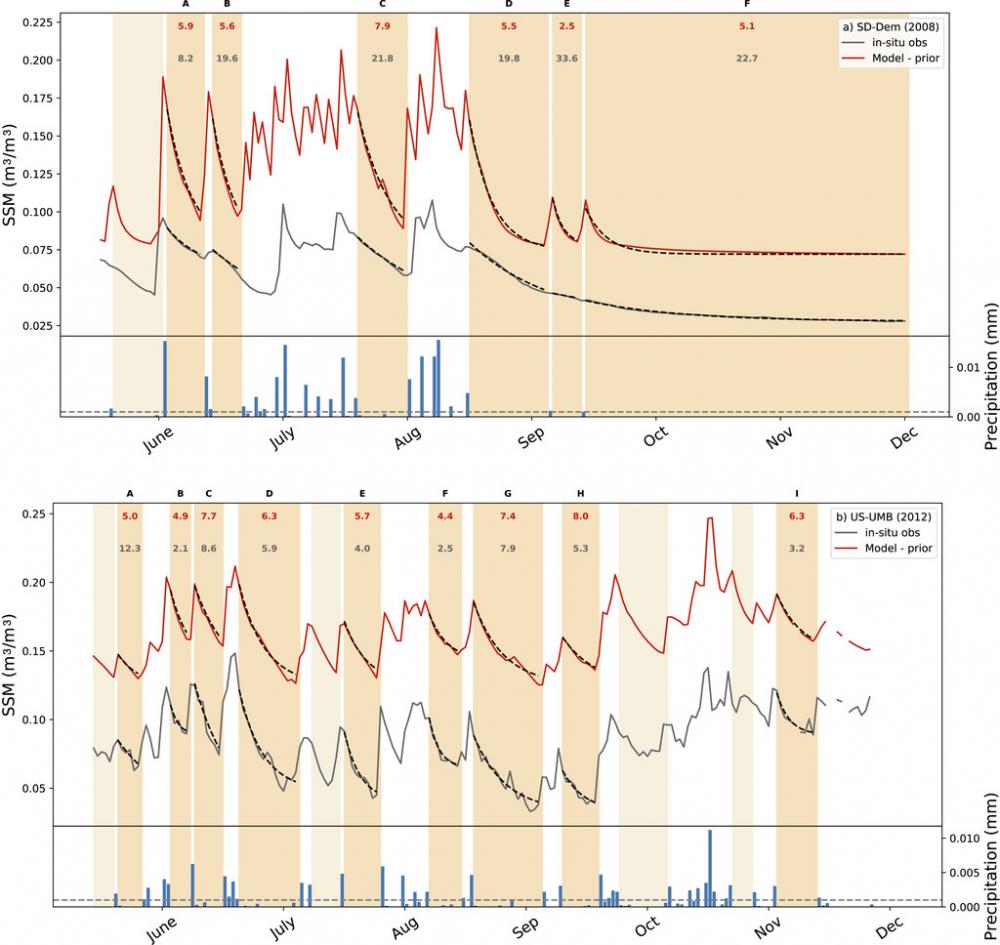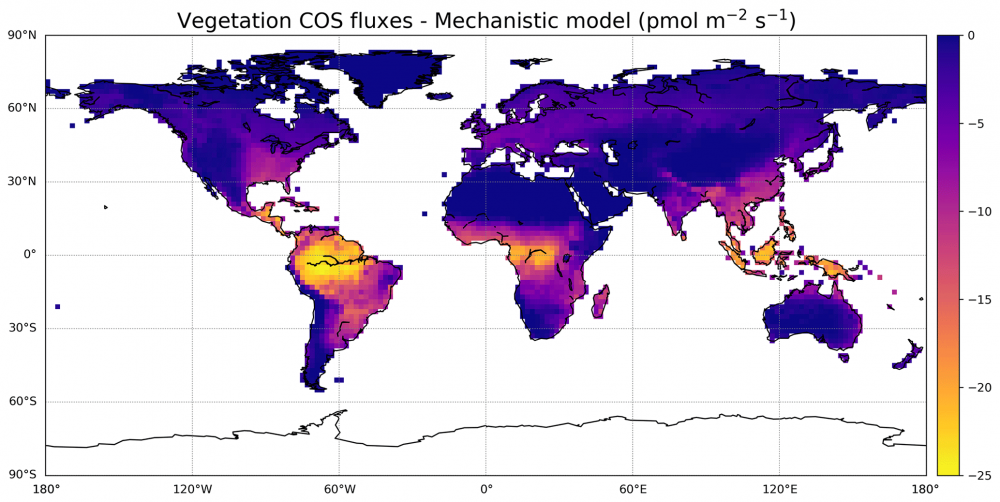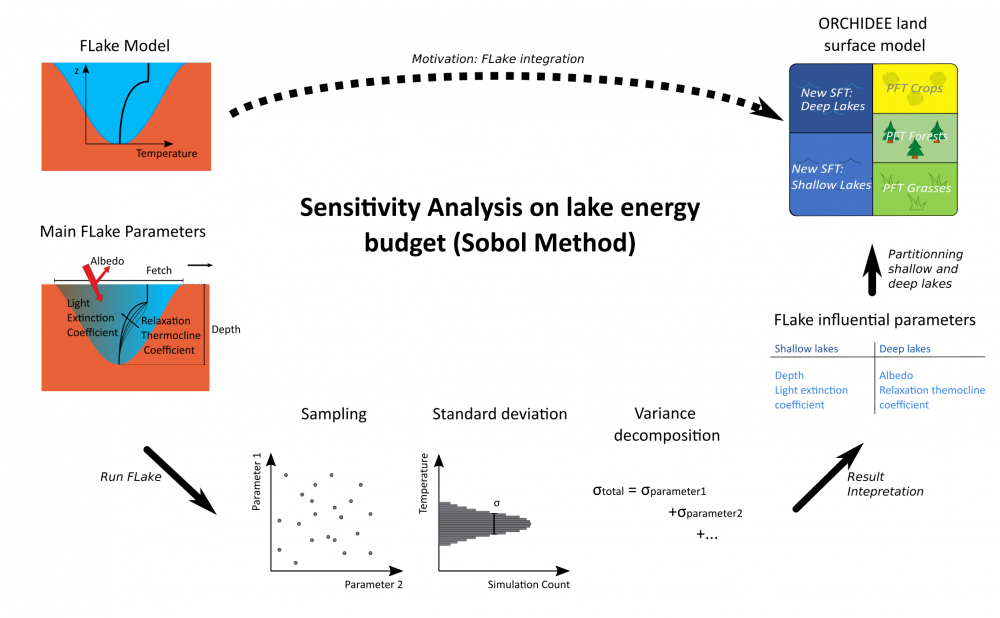Highlights 2021
The rate at which land surface soils dry following rain events is an important feature of terrestrial models. It
determines, for example, the water availability for vegetation, the occurrences of droughts, and the surface heat exchanges.
As such, surface soil moisture (SSM) ‘‘drydowns,’’ i.e., the SSM temporal dynamics following a significant rainfall event, are
of particular interest when evaluating and calibrating land surface models (LSMs). By investigating drydowns, characterized
by an exponential decay time scale t, we aim to improve the representation of SSM in the ORCHIDEE global LSM. We
consider t calculated over 18 International Soil Moisture Network sites found within the footprint of FLUXNET towers,
covering different vegetation types and climates. Using the ORCHIDEE LSM, we compare t from the modeled SSM time
series to values computed from in situ SSM measurements. We then assess the potential of using t observations to constrain
some water, carbon, and energy parameters of ORCHIDEE, selected using a sensitivity analysis, through a standard
Bayesian optimization procedure. The impact of the SSM optimization is evaluated using FLUXNET evapotranspiration
and gross primary production (GPP) data. We find that the relative drydowns of SSM can be well calibrated using
observation-based t estimates, when there is no need to match the absolute observed and modeled SSM values. When
evaluated using independent data, t-calibration parameters were able to improve drydowns for 73% of the sites.
Furthermore, the fit of the model to independent fluxes was only minutely changed. We conclude by considering the
potential of global satellite products to scale up the experiment to a global-scale optimization.
Land surface modellers need measurable proxies to constrain the quantity of carbon dioxide (CO2) assimilated by continental plants through photosynthesis, known as gross primary production (GPP). Carbonyl sulfide (COS), which is taken up by leaves through their stomates and then hydrolysed by photosynthetic enzymes, is a candidate GPP proxy. A former study with the ORCHIDEE land surface model used a fixed ratio of COS uptake to CO2 uptake normalised to respective ambient concentrations for each vegetation type (leaf relative uptake, LRU) to compute vegetation COS fluxes from GPP. The LRU approach is known to have limited accuracy since the LRU ratio changes with variables such as photosynthetically active radiation (PAR): while CO2 uptake slows under low light, COS uptake is not light limited. However, the LRU approach has been popular for COS–GPP proxy studies because of its ease of application and apparent low contribution to uncertainty for regional-scale applications. In this study we refined the COS–GPP relationship and implemented in ORCHIDEE a mechanistic model that describes COS uptake by continental vegetation. We compared the simulated COS fluxes against measured hourly COS fluxes at two sites and studied the model behaviour and links with environmental drivers. We performed simulations at a global scale, and we estimated the global COS uptake by vegetation to be −756 Gg S yr−1, in the middle range of former studies (−490 to −1335 Gg S yr−1). Based on monthly mean fluxes simulated by the mechanistic approach in ORCHIDEE, we derived new LRU values for the different vegetation types, ranging between 0.92 and 1.72, close to recently published averages for observed values of 1.21 for C4 and 1.68 for C3 plants. We transported the COS using the monthly vegetation COS fluxes derived from both the mechanistic and the LRU approaches, and we evaluated the simulated COS concentrations at NOAA sites. Although the mechanistic approach was more appropriate when comparing to high-temporal-resolution COS flux measurements, both approaches gave similar results when transporting with monthly COS fluxes and evaluating COS concentrations at stations. In our study, uncertainties between these two approaches are of secondary importance compared to the uncertainties in the COS global budget, which are currently a limiting factor to the potential of COS concentrations to constrain GPP simulated by land surface models on the global scale.
Authors: Maignan, F., Abadie, C., Remaud, M., Kooijmans, L. M. J., Kohonen, K.-M., Commane, R., Wehr, R., Campbell, J. E., Belviso, S., Montzka, S. A., Raoult, N., Seibt, U., Shiga, Y. P., Vuichard, N., Whelan, M. E., and Peylin, P.
Ref: Biogeosciences, 18, 2917–2955, https://doi.org/10.5194/bg-18-2917-2021, 2021.
Given the ever increasing spatial resolution of climate models and the significant role of lakes on the regional climate, it becomes important to represent water bodies in climate models. Such developments have started in the IPSL (Institut Pierre Simon Laplace) climate model and its land surface component, ORganizing Carbon and Hydrology In Dynamic Ecosystems (ORCHIDEE), with the Freshwater Lake model, FLake. To answer the questions raised by these new developments, such as the lake differentiation and related model parameters, we analyze spatial distributions of lake characteristics in the whole world to perform a global sensitivity analysis of the FLake parameters. As a result, three different climates and four lake depth configurations were selected as test cases. The Sobol method as sensitivity analysis based on variance decomposition was chosen to rank parameters impact on the model output, that is, lake surface water temperature, latent and sensible heat fluxes. We focus on the 11 parameters of the FLake model, which are the lake depth, the albedo and light extinction coefficient of water, snow, and ice respectively, the fetch, and the relaxation coefficient of the thermocline shape factor. The results show different sensitivity features according to the lake type and climate. The dominant role and time varying contribution of the lake depth, radiative parameters (albedo, light extinction coefficient) and thermocline relaxation coefficient linked to the atmospheric conditions, were clearly highlighted. These findings will lead us to distinguish between different lake categories in each grid cell of ORCHIDEE in the future implementation.
Authors: Antnony Bernus, Catherine Ottlé, Nina Raoult
Ref: Journal of Geophysical Research: Atmospheres, 126, e2019JD031928. https://doi.org/10.1029/2019JD031928
The rate at which land surface soils dry following rain events is an important feature of terrestrial models. It
determines, for example, the water availability for vegetation, the occurrences of droughts, and the surface heat exchanges.
As such, surface soil moisture (SSM) ‘‘drydowns,’’ i.e., the SSM temporal dynamics following a significant rainfall event, are
of particular interest when evaluating and calibrating land surface models (LSMs). By investigating drydowns, characterized
by an exponential decay time scale t, we aim to improve the representation of SSM in the ORCHIDEE global LSM. We
consider t calculated over 18 International Soil Moisture Network sites found within the footprint of FLUXNET towers,
covering different vegetation types and climates. Using the ORCHIDEE LSM, we compare t from the modeled SSM time
series to values computed from in situ SSM measurements. We then assess the potential of using t observations to constrain
some water, carbon, and energy parameters of ORCHIDEE, selected using a sensitivity analysis, through a standard
Bayesian optimization procedure. The impact of the SSM optimization is evaluated using FLUXNET evapotranspiration
and gross primary production (GPP) data. We find that the relative drydowns of SSM can be well calibrated using
observation-based t estimates, when there is no need to match the absolute observed and modeled SSM values. When
evaluated using independent data, t-calibration parameters were able to improve drydowns for 73% of the sites.
Furthermore, the fit of the model to independent fluxes was only minutely changed. We conclude by considering the
potential of global satellite products to scale up the experiment to a global-scale optimization.
Land surface modellers need measurable proxies to constrain the quantity of carbon dioxide (CO2) assimilated by continental plants through photosynthesis, known as gross primary production (GPP). Carbonyl sulfide (COS), which is taken up by leaves through their stomates and then hydrolysed by photosynthetic enzymes, is a candidate GPP proxy. A former study with the ORCHIDEE land surface model used a fixed ratio of COS uptake to CO2 uptake normalised to respective ambient concentrations for each vegetation type (leaf relative uptake, LRU) to compute vegetation COS fluxes from GPP. The LRU approach is known to have limited accuracy since the LRU ratio changes with variables such as photosynthetically active radiation (PAR): while CO2 uptake slows under low light, COS uptake is not light limited. However, the LRU approach has been popular for COS–GPP proxy studies because of its ease of application and apparent low contribution to uncertainty for regional-scale applications. In this study we refined the COS–GPP relationship and implemented in ORCHIDEE a mechanistic model that describes COS uptake by continental vegetation. We compared the simulated COS fluxes against measured hourly COS fluxes at two sites and studied the model behaviour and links with environmental drivers. We performed simulations at a global scale, and we estimated the global COS uptake by vegetation to be −756 Gg S yr−1, in the middle range of former studies (−490 to −1335 Gg S yr−1). Based on monthly mean fluxes simulated by the mechanistic approach in ORCHIDEE, we derived new LRU values for the different vegetation types, ranging between 0.92 and 1.72, close to recently published averages for observed values of 1.21 for C4 and 1.68 for C3 plants. We transported the COS using the monthly vegetation COS fluxes derived from both the mechanistic and the LRU approaches, and we evaluated the simulated COS concentrations at NOAA sites. Although the mechanistic approach was more appropriate when comparing to high-temporal-resolution COS flux measurements, both approaches gave similar results when transporting with monthly COS fluxes and evaluating COS concentrations at stations. In our study, uncertainties between these two approaches are of secondary importance compared to the uncertainties in the COS global budget, which are currently a limiting factor to the potential of COS concentrations to constrain GPP simulated by land surface models on the global scale.
Authors: Maignan, F., Abadie, C., Remaud, M., Kooijmans, L. M. J., Kohonen, K.-M., Commane, R., Wehr, R., Campbell, J. E., Belviso, S., Montzka, S. A., Raoult, N., Seibt, U., Shiga, Y. P., Vuichard, N., Whelan, M. E., and Peylin, P.
Ref: Biogeosciences, 18, 2917–2955, https://doi.org/10.5194/bg-18-2917-2021, 2021.
Given the ever increasing spatial resolution of climate models and the significant role of lakes on the regional climate, it becomes important to represent water bodies in climate models. Such developments have started in the IPSL (Institut Pierre Simon Laplace) climate model and its land surface component, ORganizing Carbon and Hydrology In Dynamic Ecosystems (ORCHIDEE), with the Freshwater Lake model, FLake. To answer the questions raised by these new developments, such as the lake differentiation and related model parameters, we analyze spatial distributions of lake characteristics in the whole world to perform a global sensitivity analysis of the FLake parameters. As a result, three different climates and four lake depth configurations were selected as test cases. The Sobol method as sensitivity analysis based on variance decomposition was chosen to rank parameters impact on the model output, that is, lake surface water temperature, latent and sensible heat fluxes. We focus on the 11 parameters of the FLake model, which are the lake depth, the albedo and light extinction coefficient of water, snow, and ice respectively, the fetch, and the relaxation coefficient of the thermocline shape factor. The results show different sensitivity features according to the lake type and climate. The dominant role and time varying contribution of the lake depth, radiative parameters (albedo, light extinction coefficient) and thermocline relaxation coefficient linked to the atmospheric conditions, were clearly highlighted. These findings will lead us to distinguish between different lake categories in each grid cell of ORCHIDEE in the future implementation.
Authors: Antnony Bernus, Catherine Ottlé, Nina Raoult
Ref: Journal of Geophysical Research: Atmospheres, 126, e2019JD031928. https://doi.org/10.1029/2019JD031928









